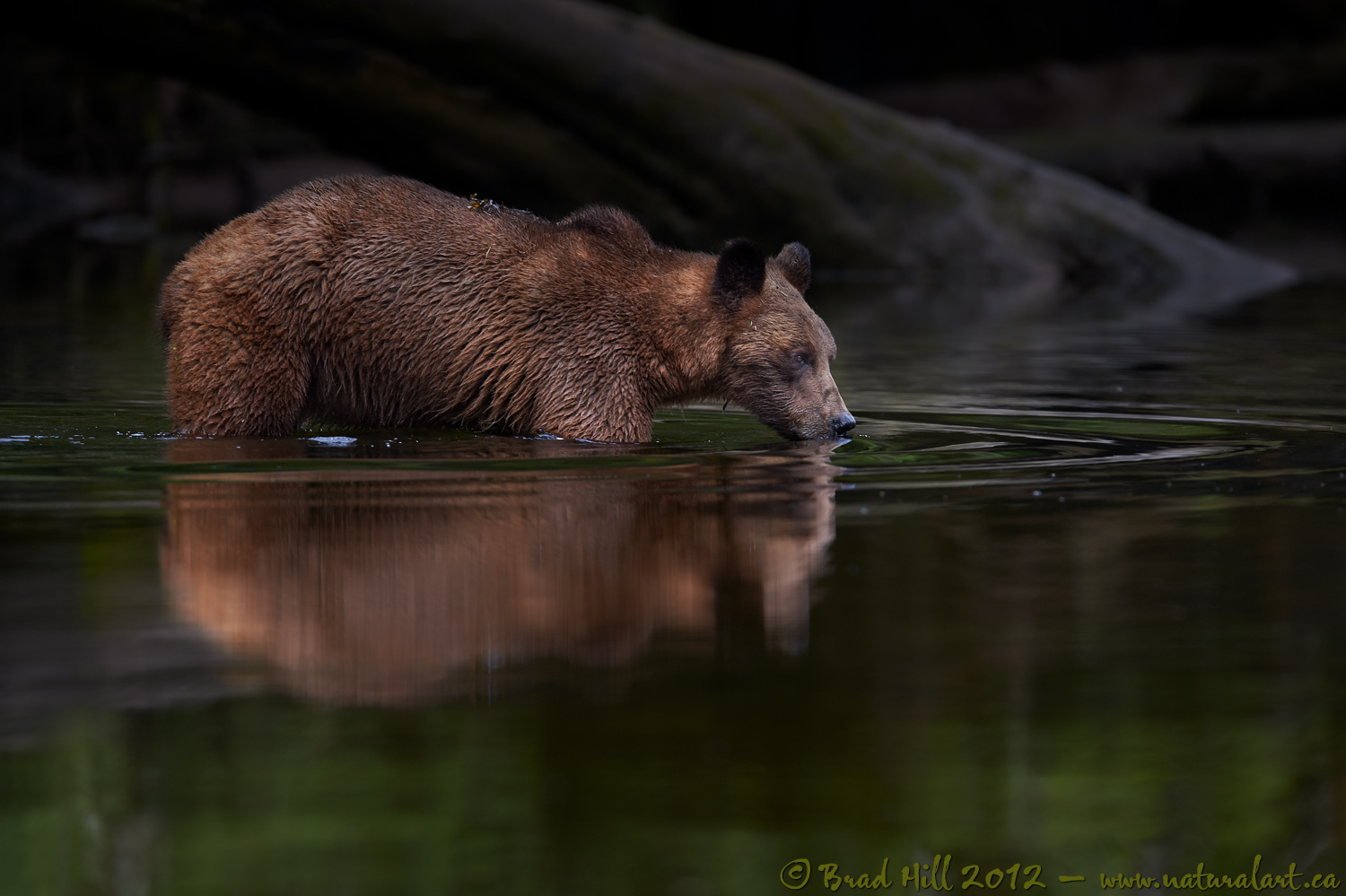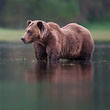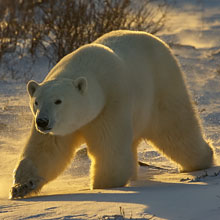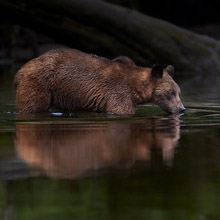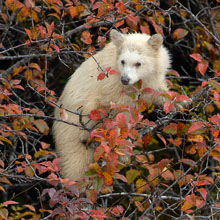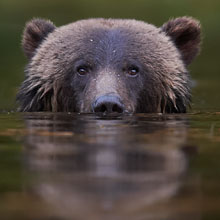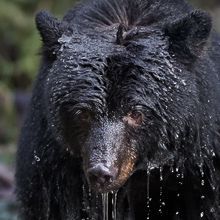Availability: Undetermined - Enquiries?
In the Field
Touching the Void. Khutzeymateen Grizzly Sanctuary, Great Bear Rainforest, BC, Canada. May 31, 2012.
My apologies to Joe Simpson for co-opting the title of his excellent book for this image...
As a terrestrial being who limits most of his aquatic activity to the surface region of waters, I always think of the depths below as mysterious "voids" that may contain...well...most anything my imagination can conjure up. Bears, in contrast, seem to have no such reservations and they just wade right in! When this female grizzly lowered her snout and kissed the water's surface (and her reflection) it was - at least to me - a particularly evocative moment in time. It was like she was "touching the void". I felt fortunate to be there to record it.
Posting a dark, moody image like this in a digital format (i.e., online) has some risk to it. A key to this image is the soft, delicate - and somewhat nuanced - lighting striking the bear. The brightness of the display of the device used to view this image will make a large difference to how this image appears, which is totally out of my control. But I do have a suggestion: if the lighting of this image doesn't appear "right" to you, simply change the angle of view (tilt) of your viewing device to suit your taste. And there you go - your own custom image! ;-)
I've heard many people say that photography has gotten "easier" since it has gone through the digital revolution. This is probably true for the "snap-shooting" public - they can capture images with their compact cell phones that in many ways surpass the quality of what they usually captured with their 35mm SLR's. And the images are certainly easier and more convenient to share than their old print or slides were.
But some serious photographers - from virtually all the various disciplines of photography - have struggled with the transition to digital photography. On one hand, the bar has gotten FAR higher - we can now capture images that couldn't have even been considered a few short years ago. And, on the other hand, the processing of images is no longer something you normally "hand-off" to a faceless lab - it has fallen squarely in the lap of the photographer. There were, of course, always SOME photographers who processed their own images (Ansel Adams might come to mind). But for the majority of nature and wildlife photographers the process functionally ended the moment they released the shutter. Inheriting the processing of the images is something that many nature photographers have been reluctant to accept (often because they simply don't enjoy sitting in front of a computer). But those relatively few nature photographers who have chosen to "dive right in" (into the void??) often end up with the ability to regularly produce images that far surpass those less comfortable with "pushing pixels" around. Yes, image capture is critical (Garbage In, Garbage Out), but for many images the processing is just as important (and sometimes MORE important) to the success of the final image.
And...those who REALLY get digital and pay attention to their processing soon realize that what they've learned behind the computer can affect the way they capture their images. This image is a good example of what I mean. When capturing this dark scene I was keenly aware that I had to under-expose the scene fairly dramatically - if I let the light meter attempt to produce a "neutral gray" scene on this one the critical lighter regions on the bear's snout and nose would have been completely blown out. But, because of my past experience behind the computer processing D4 files I knew I could use a variety of digital techniques to draw out the shadow details and work the mid-tones on the bear to return this scene to how I perceived it in the field. If I hadn't had this experience it's likely I would have refrained from under-exposing the image to the degree I did and would have risked blowing out the highlights, which would have pretty much killed the shot.
The down side to the digital revolution? Man, so much for the digital nature photographer to think about in the field (seriously). Makes it almost feel like being at work! ;-)
This image is best seen in a higher resolution form. So here's a 2400 pixel version for your perusal and enjoyment:
• Touching the Void: Download 2400 pixel image (JPEG: 0.9 MB)
ADDITIONAL NOTES:
1. This image - in all resolutions - is protected by copyright. I'm fine with personal uses of them (including use as desktop backgrounds or screensavers on your own computer), but unauthorized commercial use of the image is prohibited by law. Thanks in advance for respecting my copyright!
2. This image was captured during one of my two spring "Grizzlies of the Khutzeymateen" photo tours in May/June of 2012. Each year I offer trips into two different parts of the Great Bear Rainforest as well as one to photograph aquatic mammals and oceanscapes near the northern tip of Vancouver Island. And, in selected years, I also offer photo tours to locations to capture other highly sought-after subjects, such as various boreal owl species and wildlife of Canada's Arctic. Details about these trips can be found on the Photo Tours page of this website.
3. Like all wildlife photographs on this website, this image was captured following the strict ethical guidelines described in The Wildlife FIRST! Principles of Photographer Conduct. I encourage all wildlife photographers to always put the welfare of their subjects above the value of their photographs.
Behind the Camera
Touching the Void. Khutzeymateen Grizzly Sanctuary, Great Bear Rainforest, BC, Canada. May 31, 2012.
Digital Capture; RAW 14-bit format; ISO 1250.
Nikon D4 paired with Nikkor 400mm f2.8 VRII lens. Hand-held from floating Zodiac. VR on and set to "normal" mode.
1/400s @ f4.5; -1.67 stop compensation from matrix-metered exposure setting. Auto ISO engaged with Auto shutter speed enabled (shutter speed keyed to focal length of lens with no compensation).
At the Computer
Touching the Void. Khutzeymateen Grizzly Sanctuary, Great Bear Rainforest, BC, Canada. May 31, 2012.
RAW Conversion to 16-bit TIFF, including first-pass/capture sharpening using Capture One Pro. Four raw variants (processed from raw) differing by a total of 1.80 stops in exposure - from -0.8 stops from original exposure to +1.0 stops from original exposure.
Further digital corrections on resulting 16-bit TIFF files using Adobe's Photoshop CS6 and Light Craft's Lightzone. Photoshop adjustments including compositing the raw conversion variants (layering and masking), selective colour saturation and desaturation, selective exposure adjustments, and selective sharpening for web output. Final tone tweaking (to bear only) performed using tonemapper/re-light tool in Lightzone.
Conservation
Touching the Void. Khutzeymateen Grizzly Sanctuary, Great Bear Rainforest, BC, Canada. May 31, 2012.
Ten percent of the revenue generated by this image will be donated to Raincoast*.
Species Status in Canada**: Special Concern (May 2002).
While Grizzly Bears (Ursus arctos) are not technically listed as "Endangered" in Canada, they have been extirpated from most of their historical range. Grizzly Bears are far more sensitive to intrusion/disturbance in their habitat than are Black Bears and are being increasingly forced into marginal habitat by human encroachment. The Great Bear Rainforest along the central and northern coast of British Columbia is one of the last strongholds of the Grizzly Bear in Canada, and even this population is coming under increasing pressure.
On December 18, 2017 the government of British Columbia banned grizzly hunting across the entire province. This major conservation victory came after decades of tireless work by many dedicated conservationists and ecologists and, most importantly, it reflects the opinion of the vast majority of British Columbians. And, it means that AT LEAST while the current government remains in power grizzlies are finally "safe" in British Columbia.
Now that we've at least temporarily won the battle to save grizzlies in BC, it's time to re-focus our efforts toward protecting ALL of BC's carnivores, including Gray Wolves, Black Bears, Cougars, Wolverines, and more! Simply put, there are no ecological, economic, or ethical arguments supporting the trophy hunting of carnivores.
In a great first step towards ending the hunting of carnivores throughout BC the Raincoast Conservation Foundation has developed a program designed to protect ALL carnivores within the Great Bear Rainforest. Details about this program can be found on this page on Raincoast's website. Check it out and, better yet, make a donation to help Raincoast purchase the remaining commercial hunting tenures in the Great Bear!
*The Raincoast Conservation Society (and Foundation) is an effective and efficient organization that has been fighting for protection of this unique habitat. If you are looking for a meaningful way to contribute to the conservation of this amazing ecosystem, Raincoast will provide maximal "bang" for your conservation dollars.
**as determined by COSEWIC: The Committee on the Status of Endangered Wildlife in Canada












